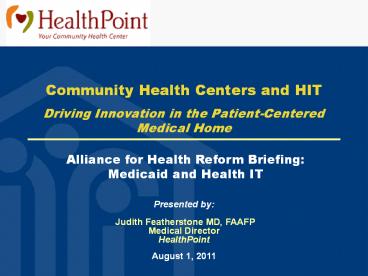Alliance for Health Reform Briefing: - PowerPoint PPT Presentation
1 / 12
Title:
Alliance for Health Reform Briefing:
Description:
Community Health Centers and HIT Driving Innovation in the Patient-Centered Medical Home Alliance for Health Reform Briefing: Medicaid and Health IT – PowerPoint PPT presentation
Number of Views:98
Avg rating:3.0/5.0
Title: Alliance for Health Reform Briefing:
1
Community Health Centers and HIT Driving
Innovation in the Patient-Centered Medical Home
Alliance for Health Reform Briefing Medicaid
and Health IT
Presented by Judith Featherstone MD,
FAAFP Medical Director HealthPoint August 1, 2011
2
Health Centers Today
- Today, Health Centers serve as the health care
home for more than 20 million patients
nationally, including - 1 in 7 Medicaid beneficiaries
- 1 in 7 uninsured persons
- 1 in 3 individuals in poverty
- 1 in 7 rural Americans
Includes patients of federally-funded health
centers, non-federally funded health centers or
Look-Alikes
3
HealthPoint Your Community Health Center
- HealthPoint is the largest CHC in the 14th
largest county in the US. - 12 Clinics 7 medical, 4 dental, 1 school-based
- Patients 62,542, Visits 210,865
- Medicaid, Medicare and Public Insurance- 55
- Uninsured 37
- In addition to primary medical and dental care,
services include - Prenatal care and delivery
- Complementary and alternative medicine including
naturopathic medicine, acupuncture and nutrition
counseling - Behavioral health
- Pharmacies in all clinics
4
HealthPoint Patients
Patient race/ethnicity
Patient income by Federal Poverty Level
Patient by insurance
5
Health Centers and HIT National Perspective
- Nationally, three quarters of all health centers
are now on the road to adopting integrated health
information technology systems.
6
HealthPoint Perspective
- 2005 Electronic Health Record/ Practice
Management Adoption - 2007 Quality of Care Outcomes Reports
- 2007 Immunization Data Interface with the State
Registry - 2008 Population Recall Reports
- 2008-11 Templates for Behavioral Health, MSS,
Homeless care - 2008 Electronic Prescribing
- 2010 Internal Pharmacy System Integrates with
EHR, - 2010 Electronic Dental Record Integrates with
EHR, - 2011 Billing from EHR
- 2011 Future Patient Portal, HIE, Enhanced
Reporting and Decision Support
7
Challenges to Adopting Health IT
- Equipment
- Staff training
- Provider use
- Reassignment of Medicaid HIT Incentive Payments
8
Opportunities for Health IT Support
- Medicaid HIT Incentive Payments
- Health Center Controlled Networks
- Primary Care Associations
- Regional Extension Centers
9
Health Centers and HIT National Perspective
- Health centers use Health IT in varied ways to
meet the needs of their patients, for example - Telehealth patients, including those in rural or
remote areas, can see a provider for
screenings, behavioral health encounters, remote
eye exams, and chronic disease management. - Referral Tracking the record, patient history,
medication and Rx plan follows the patient across
health center sites and other health care
providers. - Personal Chronic Care Management electronic
records notify providers and patients when its
time for a check up or check in.
10
Innovations at HealthPoint
- EHR
- Specialist guidelines for referrals built into
EHR. - Coordination of EDR and EHR
- Tracking referral completion
- Managing for quality of care outcomes
- Reports on health disparities to target community
approaches.
- Other
- Video interpretation
- Mobile phones for health reminders
- Website with links to mobile applications for
healthy living. - Telepharmacies
11
Health IT Improving the PCMH
- Patient Experience
- Time of visit activities
- Invite in for individual visit or group with
cohort. - Coordinate with specialists, ER and hospital,
decrease redundant work. - Decision support built in for referral
appropriateness, referral preparation, evidence
based testing.
- Population Care
- Outreach to patients due for health maintenance
services - Outreach to patients with chronic diseases which
are uncontrolled or due for monitoring. - Reports can guide us in setting up appropriate
systems such as community health workers for new
immigrant populations. - Develop interventions targeting obesity based on
our reports including language and ethnicity.
12
Health IT Improving the PCMH
- Patient-Centered Medical Home
- Six standards align with the core components of
primary care - 1)Enhance Access and Continuity
- 2)Identify and Manage Patient Populations
- 3)Plan and Manage Care
- 4)Provide Self-Carte Support and Community
Resources - 5)Track and Coordinate Care
- 6)Measure and Improve Performance
- Health IT is vital to meet these standards.































